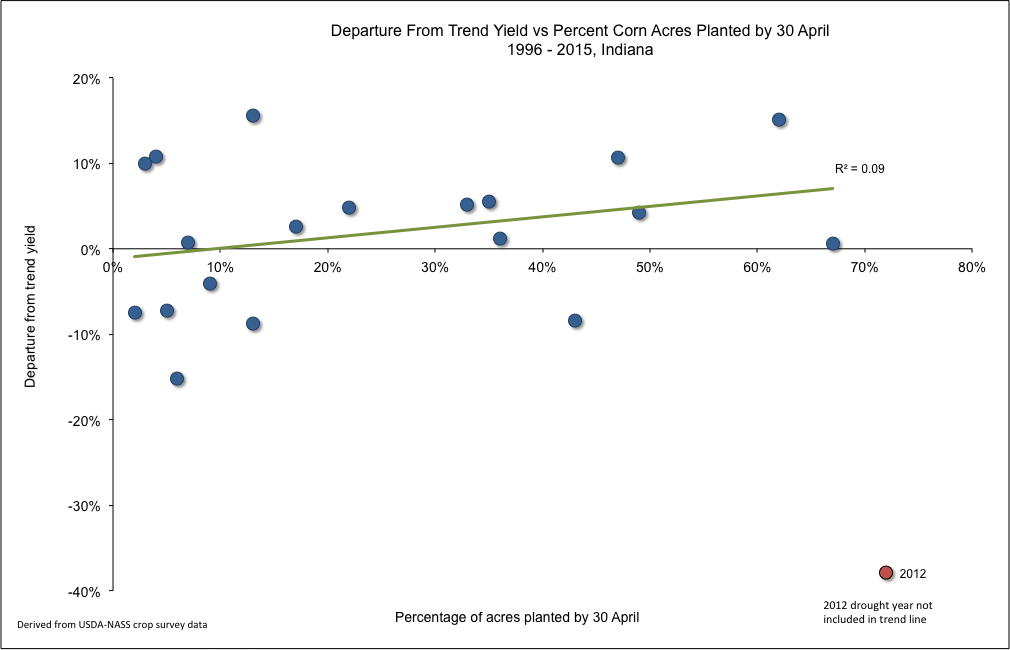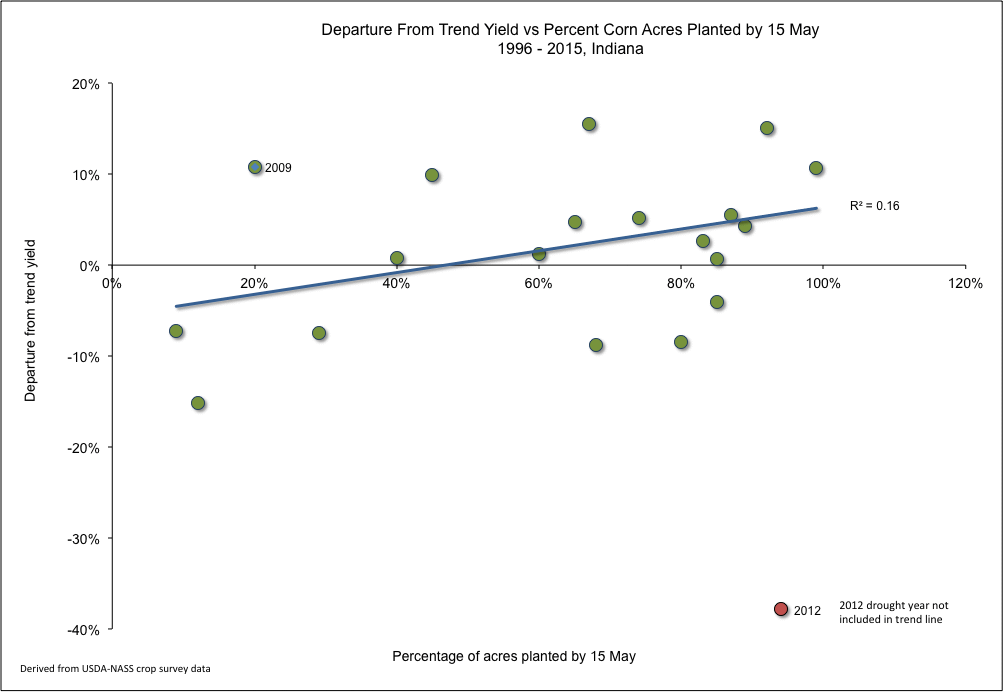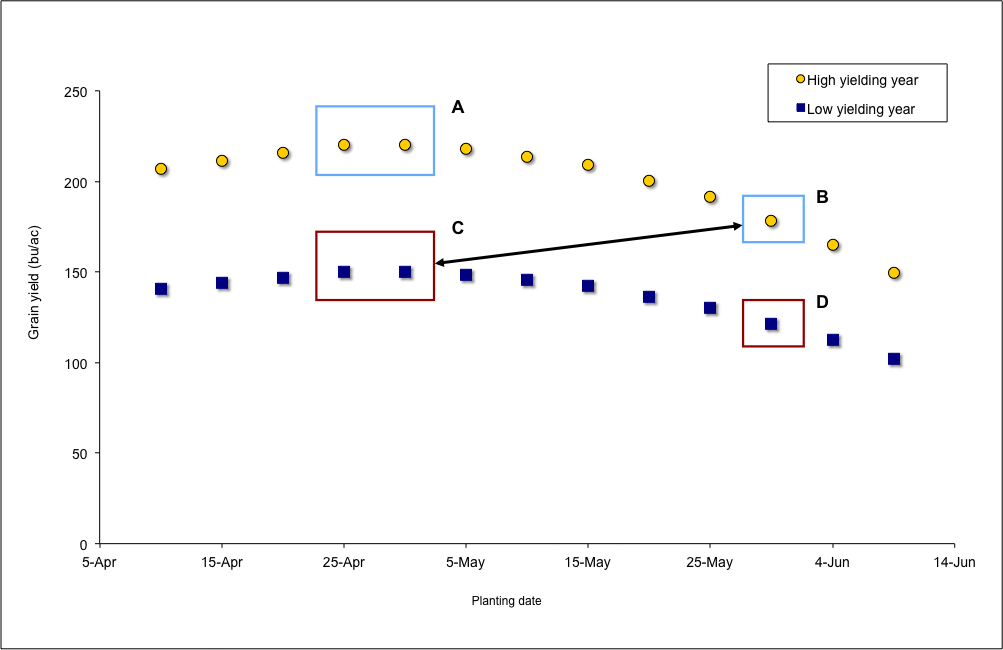By R.L. (Bob) Nielsen, Extension Corn Specialist
Conventional wisdom says that the prime planting window to maximize corn yields in much of Indiana opens about April 20 and closes about May 10. This “window” typically opens about 1 week later across the northern tier of Indiana counties (later warmup) and about 1 week earlier across the southern tier of Indiana counties (earlier warmup).
In 2016, the planting season for corn in Indiana was a slow and lengthy one, with only 62% of the state's corn crop reported as planted by May 22, compared to the running 5-year average of 77%.
What are the consequences of a delayed start to planting? How important a predictor of statewide corn yield is planting date anyway? Does late planting in and of itself guarantee lower than normal yields? Good questions, but the effect of planting date on statewide average corn yield is simply not clearcut.
If one reviews USDA-NASS crop progress reports for the past 20 years (USDA-NASS, 2016b), there is NOT a strong relationship between planting date and absolute yield on a statewide basis for Indiana. Specifically, percent departures from annual trend yields are not strongly related to corn planting progress. Figures 1 and 2 illustrate this relationship for two measures of statewide planting progress; percent acres planted by April 30 or by May 15.
Even though one can statistically define mathematical relationships between departures from statewide trend yield and statewide planting progress by April 30 or May 15, the relationships only account for 9-16% of the variability in trend yield departures from year to year. In other words, a number of yield influencing factors (YIFs) in addition to planting date also affect the ultimate absolute yield for a given year.
 Figure 1. Percent departure from statewide trend yield vs. percent of corn acres planted by April 30 in Indiana, 1996-2015.
Figure 1. Percent departure from statewide trend yield vs. percent of corn acres planted by April 30 in Indiana, 1996-2015.
 Figure 2. Percent departure from statewide yield trend vs. percent of corn acres planted by May 15 in Indiana, 1996-2015.
Figure 2. Percent departure from statewide yield trend vs. percent of corn acres planted by May 15 in Indiana, 1996-2015.
Here's the Conundrum
Why is it that every corn agronomist worth their salt preaches about the importance of timely planting and yet the statewide statistical data suggests that planting date accounts for less than 20% of the variability in statewide yields from year to year? Let's look more closely at this apparent conundrum.
It is true that relative grain yield potential of corn declines with delayed planting after about May 1 (Myers & Wiebold, 2013, Nafziger, 2008; Nafziger, 2011). Estimated yield loss per day with delayed planting varies from about 0.3% per day early in May to about 1% per day by the end of May. Yield potential goes down with delayed planting because of a number of factors, including a shorter growing season, greater insect & disease pressure, and higher risk of hot, dry conditions during pollination.
However, the good news is that planting date is only one of many YIFs for corn. What is important to understand is that yield loss due to delayed planting is relative to the maximum possible yield in a given year.
In other words, if all the other YIFs work together to determine that the maximum possible yield this year for the optimum planting date is 220 bushels per acre, then the consequence of a 10-day planting delay beyond April 30 (at 0.3% decrease per day) would be a yield potential of about 213 bushels per acre (i.e., 220 bushel potential minus [10 days x 0.3%] due to delayed planting). However, if all the other YIFs work together to determine that the maximum possible yield this year for the optimum planting date is only 150 bushels per acre, then the consequence of a 10-day planting delay beyond May 1 (at 0.3% decrease per day) would be a yield potential of about 146 bushels per acre (i.e., 150 bushels per acre potential minus [10 days x 0.3%] due to delayed planting). Make sense?
Consequently, it is possible for early-planted corn in one year to yield more than, less than, or equal to later-planted corn in another year depending on the exact combination of YIFs for each year. Figure 3 illustrates this often confusing concept. In that graph, a delayed planting of corn in an otherwise high-yielding year (B) may still be higher yielding than a crop planted on the optimum planting date in an otherwise lower-yielding year (C). Farmers know this to be true because some have had June-planted crops in recent years that ultimately yielded better than any crop they have ever had; because the remainder of the growing season following the delayed planting was exceptional.
 Figure 3. The planting date conundrum relative to absolute yield potential: A delayed planted crop in one year (B) can yield better than a crop planted on the optimum date in another year (C).
Figure 3. The planting date conundrum relative to absolute yield potential: A delayed planted crop in one year (B) can yield better than a crop planted on the optimum date in another year (C).
For example, the crop years 2012 and 2009 represent early and late planting date years, respectively, in Indiana. About 94% of the state's corn crop was planted by May 15 in 2012, but only 20% of the crop was planted by May 15 of 2009 (Fig. 2). Yet, the earlier planted 2012 crop yielded 38.2% BELOW trend yield for that year and the later planted 2009 crop yielded 10.3% ABOVE trend yield. Why? Important differences in YIFs between the years other than simply the planting dates.
Bottom Line
Let's not succumb quite yet to fear mongering triggered by the frustrations of planting the 2017 corn crop. “Mudding in” a crop early to avoid planting late will almost always end up being an unwise decision.
Furthermore, since delayed planting by itself is no guarantee of lower ABSOLUTE grain yield, I see little reason to change any crop inputs because of delayed planting, other than possibly seeding rates. Delayed planting generally coincides with warmer soil temperatures compared to early planting. Consequently, stand establishment may be more successful with delayed planting, resulting in established plant populations that are closer to actual seeding rates than the usual 90-95% success rate with earlier planting dates. So, you might consider slightly reducing your seeding rates with delayed planting.
When faced with prospects of delayed planting, one should certainly look for ways to expedite the planting process by delaying some field operations (Thomison et al., 2015) because there is no reason to purposefully plant any later than necessary.






Post a comment
Report Abusive Comment